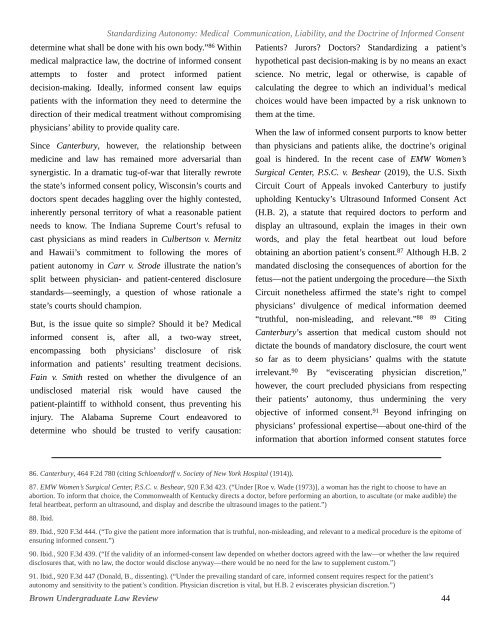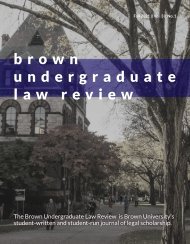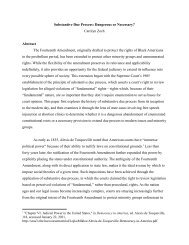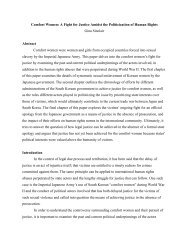Brown Undergraduate Law Review — Vol. 2 No. 2 (Spring 2021)
We are proud to present the Spring 2021 issue of the Brown Undergraduate Law Review. We hope that the works contained herein offer insight and inspiration to all who read them.
We are proud to present the Spring 2021 issue of the Brown Undergraduate Law Review. We hope that the works contained herein offer insight and inspiration to all who read them.
You also want an ePaper? Increase the reach of your titles
YUMPU automatically turns print PDFs into web optimized ePapers that Google loves.
Standardizing Autonomy: Medical Communication, Liability, and the Doctrine of Informed Consent<br />
determine what shall be done with his own body.? 86 Within<br />
medical malpractice law, the doctrine of informed consent<br />
Patients? Jurors? Doctors? Standardizing a patient?s<br />
hypothetical past decision-making is by no means an exact<br />
attempts to foster and protect informed patient science. <strong>No</strong> metric, legal or otherwise, is capable of<br />
decision-making. Ideally, informed consent law equips<br />
patients with the information they need to determine the<br />
direction of their medical treatment without compromising<br />
physicians?ability to provide quality care.<br />
Since Canterbury, however, the relationship between<br />
medicine and law has remained more adversarial than<br />
synergistic. In a dramatic tug-of-war that literally rewrote<br />
the state?s informed consent policy, Wisconsin?s courts and<br />
doctors spent decades haggling over the highly contested,<br />
inherently personal territory of what a reasonable patient<br />
needs to know. The Indiana Supreme Court?s refusal to<br />
cast physicians as mind readers in Culbertson v. Mernitz<br />
and Hawaii?s commitment to following the mores of<br />
patient autonomy in Carr v. Strode illustrate the nation?s<br />
split between physician- and patient-centered disclosure<br />
standards? seemingly, a question of whose rationale a<br />
state?s courts should champion.<br />
calculating the degree to which an individual?s medical<br />
choices would have been impacted by a risk unknown to<br />
them at the time.<br />
When the law of informed consent purports to know better<br />
than physicians and patients alike, the doctrine?s original<br />
goal is hindered. In the recent case of EMW Women?s<br />
Surgical Center, P.S.C. v. Beshear (2019), the U.S. Sixth<br />
Circuit Court of Appeals invoked Canterbury to justify<br />
upholding Kentucky?s Ultrasound Informed Consent Act<br />
(H.B. 2), a statute that required doctors to perform and<br />
display an ultrasound, explain the images in their own<br />
words, and play the fetal heartbeat out loud before<br />
obtaining an abortion patient?s consent. 87 Although H.B. 2<br />
mandated disclosing the consequences of abortion for the<br />
fetus? not the patient undergoing the procedure? the Sixth<br />
Circuit nonetheless affirmed the state?s right to compel<br />
physicians? divulgence of medical information deemed<br />
?truthful, non-misleading, and relevant.?<br />
But, is the issue quite so simple? Should it be? Medical<br />
Citing<br />
Canterbury?s assertion that medical custom should not<br />
informed consent is, after all, a two-way street,<br />
dictate the bounds of mandatory disclosure, the court went<br />
encompassing both physicians? disclosure of risk<br />
so far as to deem physicians? qualms with the statute<br />
information and patients? resulting treatment decisions.<br />
irrelevant.<br />
Fain v. Smith rested on whether the divulgence of an<br />
By ?eviscerating physician discretion,?<br />
however, the court precluded physicians from respecting<br />
undisclosed material risk would have caused the<br />
their patients? autonomy, thus undermining the very<br />
patient-plaintiff to withhold consent, thus preventing his<br />
objective of informed consent.<br />
injury. The Alabama Supreme Court endeavored to<br />
Beyond infringing on<br />
physicians?professional expertise? about one-third of the<br />
determine who should be trusted to verify causation:<br />
information that abortion informed consent statutes force<br />
86. Canterbury, 464 F.2d 780 (citing Schloendorff v. Society of New York Hospital (1914)).<br />
87. EMW Women?s Surgical Center, P.S.C. v. Beshear, 920 F.3d 423. (?Under [Roe v. Wade (1973)], a woman has the right to choose to have an<br />
abortion. To inform that choice, the Commonwealth of Kentucky directs a doctor, before performing an abortion, to ascultate (or make audible) the<br />
fetal heartbeat, perform an ultrasound, and display and describe the ultrasound images to the patient.?)<br />
88. Ibid.<br />
89. Ibid., 920 F.3d 444. (?To give the patient more information that is truthful, non-misleading, and relevant to a medical procedure is the epitome of<br />
ensuring informed consent.?)<br />
90. Ibid., 920 F.3d 439. (?If the validity of an informed-consent law depended on whether doctors agreed with the law? or whether the law required<br />
disclosures that, with no law, the doctor would disclose anyway? there would be no need for the law to supplement custom.?)<br />
91. Ibid., 920 F.3d 447 (Donald, B., dissenting). (?Under the prevailing standard of care, informed consent requires respect for the patient?s<br />
autonomy and sensitivity to the patient?s condition. Physician discretion is vital, but H.B. 2 eviscerates physician discretion.?)<br />
<strong>Brown</strong> <strong>Undergraduate</strong> <strong>Law</strong> <strong>Review</strong><br />
44










